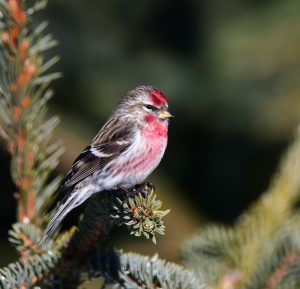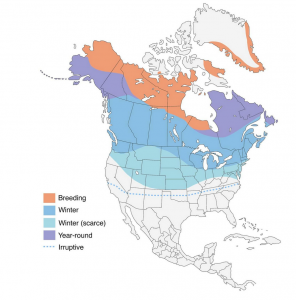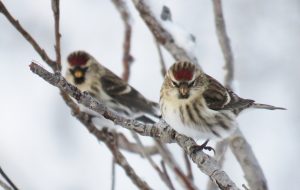Common Redpoll
(Carduelis flammea)

General Information: Common Redpolls are common Arctic and sub-Arctic breeders. Their numbers vary from year to year (irruptions) depending upon on the availability of seed.
Description: These small songbirds are members of the finch family and are about 5.25 inches in length. Females have a red or orange cap, while males have a red cap and red on the breast and sides, with distinctive black chins. The male and female have streaking of the flanks, rump, and undertail coverts and a yellow bill.
North American Range:

Source: https://www.allaboutbirds.org/guide/Common_Redpoll/maps-range
Bird Biology:
Preferred Habitat: In winter, the Common Redpoll prefers open woodlands, brushy edges, weedy fields, and is a regular visitor at bird feeders. During the summer they can be found breeding in varying habitat types: edges of spruce forests, birch stands, mixed conifer and birch, willow thickets, and low tundra shrub. They avoid dense forest.
Breeding Season: Breeding begins in late April in the western states, and June in the east. The female searches for the nest site and builds the nest on a horizontal branch or in the crotch of a spruce, alder, or willow. They nest low to the ground. On the tundra the nest is placed under a rock ledge, in low ground cover, or among driftwood.
Nest: The nest is cup-shaped, consisting of fine twigs, grasses, and plant stems, and lined with down, feathers, and hair. In the arctic, old nests may be reused, in which case the female relines the nest. Pairs will often nest near one another in loose associations.
Eggs and Incubation: Usually 4-5 eggs. Nestlings are altricial (young are unable to care for themselves when born). Female incubates the eggs 10-13 days. Young are tended by both parents. The adult pair remain together and may have from 1-3 broods in a season. That’s a lot of young ones to take care of each year.
Fledging: The young quickly grow flight feathers and fledge 11-14 days after birth.
Food Preferences: Common Redpolls are seed eaters, preferring a seed about the size of their bill. Birch catkins are a preferred seed source.
Redpolls do come to feeders, preferring nyjer or thistle seed, but also eating black oil sunflower seed. They will also scavenge opened seeds left by other birds.
Feeding Methodology: The Common Redpoll is an active communal forager generally found in flocks.
Migration: During a normal year, fall migration begins in late August and extends to early December. Spring migration is from late February to early June. Birds migrate during the day and in flocks.
The Common Redpoll is an irruptive migrant. They will move south irregularly in winter following patterns in food supply. Their winter habitat is the northern boreal forest, however every couple of years, redpolls move farther south in winter, occasionally reaching the central or southern United States. Their movements generally correspond to the availability of seeds and population response to increasing numbers.

Vocalizations:
- Song: Combination of a trill and twittering.
- Call: Swee-ee-et
- Flight Call: A dry rattle
Threats: Climate change is transforming the Common Redpoll habitat.
Fun Facts:
- During a winter night, the Common Redpoll will tunnel into the snow to stay warm. These tunnels may be more than a 12 inches long and 4 inches under the snow. Brrrr.
- The Common Redpoll can pull a string to get to a piece of hanging food. They can shake seeds out birch catkins so the seed falls to the ground where the birds easily eat them.
- Redpolls have throat pouches where they temporarily store seeds to later take to a protected, warm spot to eat.
- Some redpolls eat a diet consisting entirely of birch seeds.
- Redpolls have high-energy needs and can eat up to 42% of their body mass each day.
- Redpolls are ‘Alaska Hardy’ and have been found to survive in areas where the temperature dips to minus 65 degrees F. That’s cold!!!
- A redpoll banded in Alaska was recovered in the eastern U.S. A redpoll banded in Belgium was found in China two years later. Those are long distance trips.

Conservation Status: Common Redpolls are species of least concern, but populations are declining. Their estimated global population is 160 million.
Similar Species in Alaska: Hoary Redpoll
Sources of Information:
All About Birds. 2017. Cornell Lab of Ornithology. Downloaded on 5 June 2018, and 19 July 2018. https://www.allaboutbirds.org/guide/Common_Redpoll/id
Arthur A. Allen//Macaulay Library at the Cornell Lab
Baicich, Paul J. and Harrison, Colin J.O. 1997. Nests, Eggs, and Nestlings of North American Birds, 2nd Edition. Princeton Field Guides.
Dunn, Jon L. and Adlerfer, Jonathan, Editors. National Geographic: Field Guide to Birds of North America. Fifth Edition. 2006.
Dunne, Pete. 2006. Pete Dunne’s Essential Field Guide Companion: Comprehensive Resource for Identifying North American Birds. Houghton Mifflin Company.
Geoffrey A. Keller//Macaulay Library at the Cornell Lab
National Audubon Society. Birds of North America. Downloaded on 19 July 2018. https://www.audubon.org/field-guide/bird/common-redpoll
Sibley, David Allen. 2003. The Sibley Field Guide to Birds of Western North America. Andrew Stewart Publishing Inc.
The IUCN Red List of Threatened Species. Version 2018-1. <www.iucnredlist.org>. Downloaded on 19 July 2018.
Warnock, N. 2017. The Alaska WatchList 2017. Audubon Alaska, Anchorage, AK 99501.
It’s A Great Day to Bird